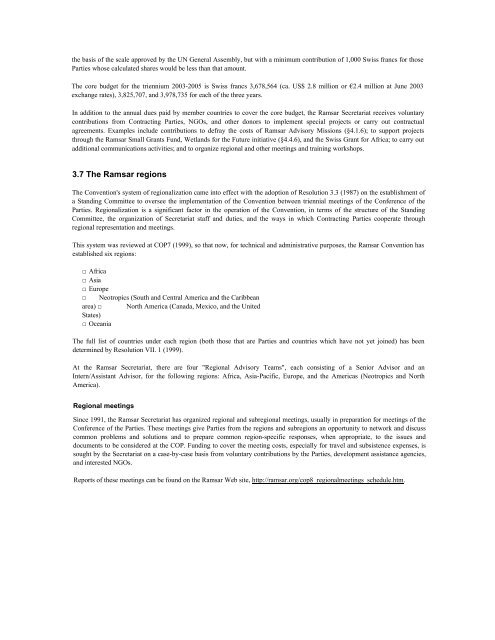The Ramsar Convention Manual.pdf
The Ramsar Convention Manual.pdf
The Ramsar Convention Manual.pdf
You also want an ePaper? Increase the reach of your titles
YUMPU automatically turns print PDFs into web optimized ePapers that Google loves.
the basis of the scale approved by the UN General Assembly, but with a minimum contribution of 1,000 Swiss francs for those<br />
Parties whose calculated shares would be less than that amount.<br />
<strong>The</strong> core budget for the triennium 2003-2005 is Swiss francs 3,678,564 (ca. US$ 2.8 million or €2.4 million at June 2003<br />
exchange rates), 3,825,707, and 3,978,735 for each of the three years.<br />
In addition to the annual dues paid by member countries to cover the core budget, the <strong>Ramsar</strong> Secretariat receives voluntary<br />
contributions from Contracting Parties, NGOs, and other donors to implement special projects or carry out contractual<br />
agreements. Examples include contributions to defray the costs of <strong>Ramsar</strong> Advisory Missions (§4.1.6); to support projects<br />
through the <strong>Ramsar</strong> Small Grants Fund, Wetlands for the Future initiative (§4.4.6), and the Swiss Grant for Africa; to carry out<br />
additional communications activities; and to organize regional and other meetings and training workshops.<br />
3.7 <strong>The</strong> <strong>Ramsar</strong> regions<br />
<strong>The</strong> <strong>Convention</strong>'s system of regionalization came into effect with the adoption of Resolution 3.3 (1987) on the establishment of<br />
a Standing Committee to oversee the implementation of the <strong>Convention</strong> between triennial meetings of the Conference of the<br />
Parties. Regionalization is a significant factor in the operation of the <strong>Convention</strong>, in terms of the structure of the Standing<br />
Committee, the organization of Secretariat staff and duties, and the ways in which Contracting Parties cooperate through<br />
regional representation and meetings.<br />
This system was reviewed at COP7 (1999), so that now, for technical and administrative purposes, the <strong>Ramsar</strong> <strong>Convention</strong> has<br />
established six regions:<br />
□ Africa<br />
□ Asia<br />
□ Europe<br />
□ Neotropics (South and Central America and the Caribbean<br />
area) □ North America (Canada, Mexico, and the United<br />
States)<br />
□ Oceania<br />
<strong>The</strong> full list of countries under each region (both those that are Parties and countries which have not yet joined) has been<br />
determined by Resolution VII. 1 (1999).<br />
At the <strong>Ramsar</strong> Secretariat, there are four "Regional Advisory Teams", each consisting of a Senior Advisor and an<br />
Intern/Assistant Advisor, for the following regions: Africa, Asia-Pacific, Europe, and the Americas (Neotropics and North<br />
America).<br />
Regional meetings<br />
Since 1991, the <strong>Ramsar</strong> Secretariat has organized regional and subregional meetings, usually in preparation for meetings of the<br />
Conference of the Parties. <strong>The</strong>se meetings give Parties from the regions and subregions an opportunity to network and discuss<br />
common problems and solutions and to prepare common region-specific responses, when appropriate, to the issues and<br />
documents to be considered at the COP. Funding to cover the meeting costs, especially for travel and subsistence expenses, is<br />
sought by the Secretariat on a case-by-case basis from voluntary contributions by the Parties, development assistance agencies,<br />
and interested NGOs.<br />
Reports of these meetings can be found on the <strong>Ramsar</strong> Web site, http://ramsar.org/cop8_regionalmeetings_schedule.htm.












